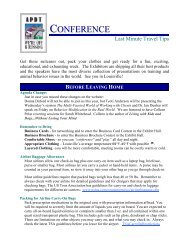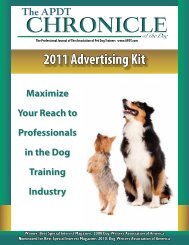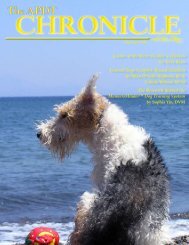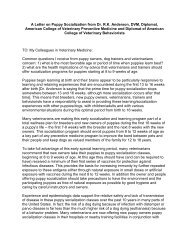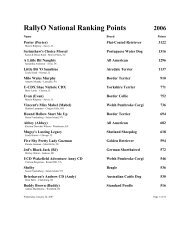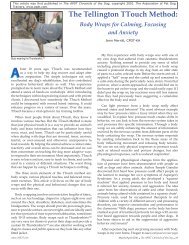of the Dog - Association of Pet Dog Trainers
of the Dog - Association of Pet Dog Trainers
of the Dog - Association of Pet Dog Trainers
You also want an ePaper? Increase the reach of your titles
YUMPU automatically turns print PDFs into web optimized ePapers that Google loves.
“We’re back on. This is for you when you get me to click.”<br />
This strategy for letting <strong>the</strong> dog know when she’s <strong>of</strong>f<br />
<strong>the</strong> clock and back on again makes it easier for <strong>the</strong> dog<br />
to maintain focus and lets her know that you’re watching<br />
out for her best interests, giving her a chance to take a<br />
break. It is analogous to your mental attitude and ability<br />
to concentrate and maintain focus at a seminar when you<br />
know <strong>the</strong>re’s a short break coming soon, versus when<br />
<strong>the</strong>re is no planned break in a long session. Fur<strong>the</strong>r, just<br />
as we build duration in training for various behaviors,<br />
teaching <strong>the</strong> dichotomy between concentration and<br />
mental relaxation—and that you’ll enable <strong>the</strong> latter—can<br />
help build duration <strong>of</strong> focus and concentration.<br />
Taking A Break In Class<br />
Taking breaks in a class environment is equally<br />
important. The dogs in class get a mental break when <strong>the</strong><br />
instructor is giving instructions to <strong>the</strong> students. Then,<br />
when <strong>the</strong>y’re practicing a behavior in class, we instruct<br />
students to give <strong>the</strong>ir dogs a short, brain-clearing break<br />
after a certain number <strong>of</strong> repetitions, teaching <strong>the</strong>m how<br />
to take breaks at home during <strong>the</strong>ir practice sessions. After<br />
a few repetitions, <strong>the</strong>y give <strong>the</strong> dog a chance to sniff <strong>the</strong><br />
floor, get a drink, or simply look around.<br />
Because we have several classes taking place at <strong>the</strong><br />
same time, we find that letting <strong>the</strong> dogs look around,<br />
perhaps to check out <strong>the</strong> dogs in <strong>the</strong> next ring running<br />
over an agility obstacle, allows <strong>the</strong>m to focus better when<br />
<strong>the</strong>ir handlers ask for it. About mid-way through <strong>the</strong> hour,<br />
<strong>the</strong> entire class takes a break so students can take <strong>the</strong>ir<br />
dogs outside, eliminating “accidents,” and giving both<br />
dogs and humans a mental break.<br />
Ending The Training Session<br />
The ultimate break, <strong>of</strong> course, is ending a training<br />
session. How you take this break can aid <strong>the</strong> dog’s learning.<br />
End with success. Smile and say “all done.” Don’t rev your<br />
dog up with strenuous play. Let him rest quietly to chew<br />
www.APDT.com<br />
1 2 3<br />
After a break, a nose-tease can reengage <strong>the</strong> dog. Briefly waft a treat under <strong>the</strong> dog’s nose (1), <strong>the</strong>n put it out <strong>of</strong> sight (2). The nose-tease is not a lure; it’s an inducement<br />
to <strong>of</strong>fer behavior—in this case, lie down (3).<br />
a bone, relax, or do whatever he’d like. He’s earned it.<br />
If you miss <strong>the</strong> opportunity to end with success, and<br />
your dog stops <strong>of</strong>fering <strong>the</strong> behaviors you want, smile<br />
none<strong>the</strong>less and give your “all done” cue. It’s not your<br />
dog’s fault that you trained beyond <strong>the</strong> dog’s ability to<br />
focus. Consider what signals you missed that indicated<br />
your dog was finished, and try to end on a better note <strong>the</strong><br />
next time.<br />
It is <strong>of</strong>ten difficult for trainers to stop training—to not<br />
drill just one more, or ask for just one additional repetition<br />
<strong>of</strong> a behavior—but <strong>of</strong>ten not training, including taking<br />
breaks, stopping for <strong>the</strong> day, providing an opportunity for<br />
latent learning, can provide <strong>the</strong> greatest benefit for those at<br />
both ends <strong>of</strong> <strong>the</strong> leash.<br />
Portions <strong>of</strong> this article are from Gail’s soon-to-be-published<br />
book, TRAINING A THINKING DOG, The Complete<br />
Crossover Guide to Clicker Training, coming this fall from<br />
<strong>Dog</strong>wise Publishing.<br />
An award-winning author and international lecturer, Gail<br />
pioneered <strong>the</strong> first university course for obedience instructors,<br />
a two-year program she developed and taught at <strong>the</strong> University<br />
<strong>of</strong> New Hampshire. She owns and operates All <strong>Dog</strong>s Gym in<br />
Manchester, NH, www.alldogsgym.com, <strong>the</strong> largest training<br />
facility in New England. Called <strong>the</strong> “trainer <strong>of</strong> trainers,” Gail<br />
had gone through two previous training incarnations before<br />
discovering clicker training 11 years ago.<br />
Photographs courtesy <strong>of</strong> Gail Tamases Fisher.<br />
November/December 2008 w The APDT Chronicle <strong>of</strong> <strong>the</strong> <strong>Dog</strong> w 19<br />
“Give Me a Break!”



